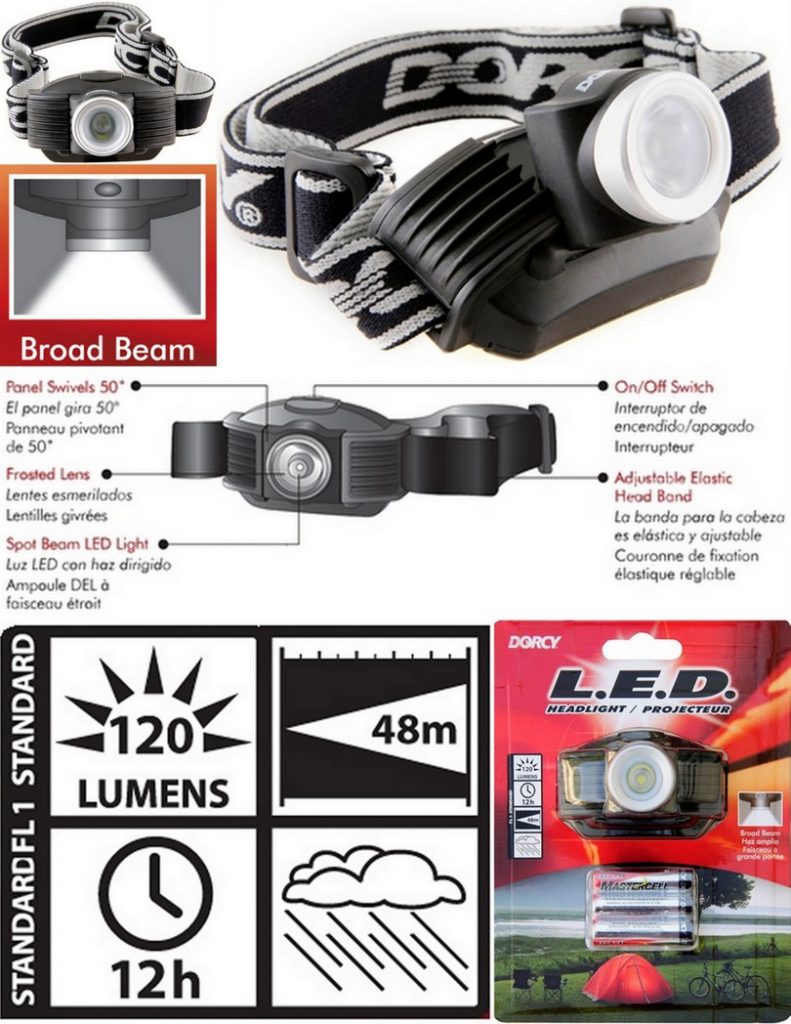Choosing a Headlamp For Winter Camping – The Dorcy 41-2016 120 Lumen Headlamp
You can’t beat the hands-free lighting convenience offered by a headlamp and always pointing where you’re looking. But what sets one headlamp apart from another? Criteria you might want to consider include:
- Light output in terms of lumens or how intensely the light shines. An average headlamp will output between 20-90 lumens. The power consumed by the LED light is measured in watt (W). Both Lumen and watt will affect the type of beam the headlamp outputs versus how much battery power it will consume. For example, a 3W headlamp would output an average of 100–150lumens, but the higher the lumens output, the more drain on the battery.
- Beam distance in terms of how far the light actually goes.
- Light bulbs. Almost all modern headlamps have LED bulbs. LEDs are basically a light bulb without a filament to burn out, and since they are very efficient at creating light without heat loss, they don’t get hot. The LEDs longevity is further enhanced by its construction. An unbreakable, crystal clear, solid resin encases each LED and makes it nearly indestructible. The drawback to LEDs is their limited output for projecting light over a great distance. LEDs have an average lifespan of 100,000 hours of continuous or cumulative use, operate on low voltage DC power, and produce no UV light. Light output of LEDs are measured in lumens; energy input to a lamp is measured in watts. The efficiency of a lamp is expressed as lumens per watt.
- LED light colors. Most headlamps come with white lights because they enhance contrast and illuminate objects in a manner that looks natural. If you have a need to preserve your night vision, look for a headlamp that also has red LED lights.
- Battery life length while projecting continuous usable light. Batteries can be expensive, so you might consider rechargeable NiMH batteries or rechargeable lithium batteries, which would be better but more expensive. Headlamps designed to work with lithium batteries are a good choice for cold-weather usage, since lithium batteries outperform alkaline batteries in cold conditions.
- Weight of the total unit (most range between 3-6 oz.) . The amount of weight you are willing to tolerate on your head is a personal decision. Keep in mind while winter camping you may be wearing a headlamp for extended hours as you set up camp, gather firewood at night, cook, and hang out during the long dark hours.
- Size of the entire unit including straps.
- Straps. Triple straps insure that the headlamp will not creep down your face during prolonged activity. Also, a triplex strap does not need to be overly tight to stay in place. However, a single strap unit is smaller and lighter.
- Light adjustments or modes. Most headlamps offer at least a high and low mode. Others may offer 3 or more modes, alternately called “brightness levels.” Here’s a breakdown, from the most energy-efficient mode to the least-efficient:
- Low beam. A power saving mode for general use. Usually a wide or flood scope.
- High. A good option for situations where you need more light to see long distances. Typically this is also provides a spot or focused beam.
- Strobe. An emergency blinker.
- Moisture resistance can be important for winter camping situation.
- Tilt. The ability to adjust the light up or down let one position the beam exactly where you want it. This is useful for reading, cooking or illuminating tasks at hand.
- The On/Off Switch may lock to prevent the headlamp from being inadvertently switched on inside a pack. You will want a switch that is glove-friendly and easily cycles through its modes.
My most recent headlamp is a small lightweight LED headlamp offered by DORCY. DORCY sells a variety of lighting related products on line including batteries, flashlights, lanterns, headlamps, spotlights, and safety lights. I used to take their new 41-2096 lightweight headlamp on my most recent winter camping trip. Let’s see how this headlamp matches up versus the criteria above.

| Light output | The lamp shone 120 lumens in a broad beam; one of the brightest lights on the market. This is more than adequate for low light conditions and night hiking, if necessary. |
| Beam distance | The unit projected to 157 feet on high beam. This is more than enough for any winter camping application. |
| Light bulbs | LED |
| LED light colors | White only. |
| Battery life | The unit came with 3 AAA Mastercell Alkaline batteries. I swapped those for Lithium batteries for superior performance in the cold. Charge length is touted as 12 hours. I did not run it continuously. |
| Weight | Only 2.9 ounces with batteries |
| Size | 2.75″ W X 1.5″ Depth |
| Straps | This single strap unit stayed secure through out camp chores, cooking and boiling water. I have never required a tri-strap for winter camping. |
| Light modes | The unit came with three modes: low (½ power), high and strobe. I primarily used the low mode in camp. |
| Moisture resistance | The unit claims to be weather resistant and certainly displayed no problems being used during windy snow squalls. |
| Tilt. | There is a 50 degree adjustment to allow for pin point focusing on tasks at hand, such as cooking. |
| On/Off Switch | The on/off switch easily cycled through the three modes. While glove friendly, the switch did turn on once while cramming items in my backpack. It was easily detected and corrected, but the easy placement bears noting when packing. |
This headlamp is an excellent choice for winter camping activities and at $24 it is a bargain. I plan to use it on all my winter camping trips this year.

